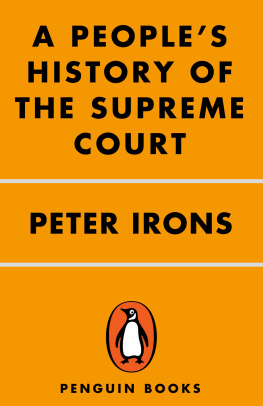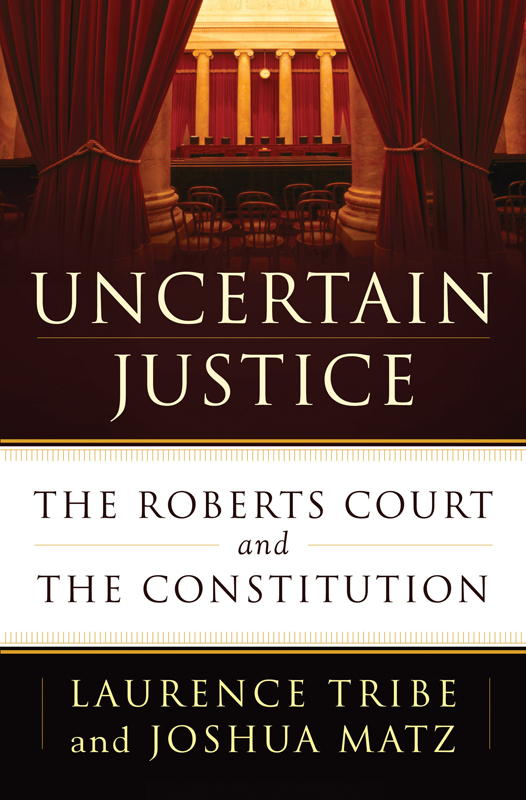Contents
Guide

The author and publisher have provided this e-book to you for your personal use only. You may not make this e-book publicly available in any way. Copyright infringement is against the law. If you believe the copy of this e-book you are reading infringes on the authors copyright, please notify the publisher at: us.macmillanusa.com/piracy.
Please note that some of the links referenced in this work are no longer active.
LT: For my children Mark and Kerry, my grandchildren Isabel, Sadie, Eno, and Emit, and my brother Al (Shurka)
JM: For Mom & Ned, Dad & Marie, Genna & Jake, and Barbara, Jerry, Neil & Terri
CONTENTS
PROLOGUE: UNCERTAIN JUSTICE
H. L. Mencken reputedly said, For every complex problem, there is a solution that is simple, neat, and wrong.
Understanding the Supreme Court undoubtedly qualifies as a complex problem. The nine justices currently issue more than seventy opinions every year, some of them thunderbolts that rock American life and others rightly destined for obscurity. With a hand in nearly every major issue of our time, from privacy and affirmative action to gun rights and health care, the Court is inescapable. Yet it is also mysterious and secretive, committed to rituals and reasoning that even experts struggle to understand. Its opinions are poked and prodded, examined under a microscope and held up to the light. The public hangs on to rumors of backroom drama, while scholars read tea leaves and prophesy the future. Clear trends predominate in certain areas of law, but efforts to develop a unified field theory of the Courtto explain its work as the result of a particular clash of politics, personalities, or principlesinevitably fall short. Even in this age of statistical models that seek to wring hidden meaning out of human behavior, the nine men and women who make up the Court intrigue and surprise us.
Consider a handful of the Courts rulings since 2005, when John G. Roberts Jr. was appointed Chief Justice of the United States. Trying to comprehend the legal precedents, constitutional philosophies, and judicial personalities that shape these wildly divergent decisions can seem overwhelming.
Of course, an effort to understand the Roberts Courtmuch like an effort to understand the Court at any point in historymust reckon with more than just its results. The Court issues opinions in which the justices grapple with fundamental principles, argue over what the Constitution means and what role they should play in giving it life, and offer signals of where they are heading. These opinions open a window into the justices hearts and minds, giving us a glimpse of how they view the world. In many cases, the justices decisions, as well as their concurrences and dissents, also exert a magnetic pull on American life, both in their practical effects and through their bold interventions in our discourse. When Justice Sandra Day OConnor warned that a state of war is not a blank check for the President, they spoke to the public about constitutional values in ways that cant simply be reduced to how they voted in those cases.
Judicial opinions, though, can defy easy comprehension. Far too often, their meaning is misunderstood. It doesnt help that in controversial cases, the Court frequently erupts in a confusing cacophony of competing writings. Nor do its opinions always offer a comprehensive and transparent view of the Court; sometimes they are downright misleading.
The complex problem, then, is that the Supreme Court presents many kinds of uncertainty: What is really going on within the Court? What moves the justices to take the actions they do? How will they resolve the issues that reach them in the future? What roles do they see for themselves? Are they achieving what the Constitution requires or justice demands?
To be sure, this uncertainty has its limits. The Court is not a legal randomizer, emitting new constitutional rules without rhyme or reason. In less than a decade, for instance, the Roberts Court has wrought remarkable and directed changes in many areas of the law, forever transforming how the Constitution is understood. Yet the shifting boundaries of what we can know about the Court, the futures that seem likely and the precedents not long for this world, tell a captivating story in their own right. As Carl von Clausewitz observed, Although our intellect always longs for clarity and certainty, our nature often finds uncertainty fascinating.
In some important domains of constitutional law, a majority of the Roberts Court stands on the brink of revolution yet seems profoundly uncertain about whether and how to proceed. In other domains, it has already initiated major changes whose long-term effects are clouded in mystery. Some of these developments reflect a desire by the justices to remake our constitutional understanding, while others have been forced by dramatic cultural, technological, and political upheaval. Although uncertainty is not unique to the Roberts Courtit is always part of life at the Marble Palaceit affords an especially helpful entry point to this Court.
* * *
Many of the most important stories of the Roberts Court consist not of definitive rulings but of the portents and fault lines that lurk in opinions and hint at what lies ahead. In this book, we show how conventional wisdom on these matters is often misleading, and we draw out the latent meaning of many of this Courts most important opinions to identify the uncertainties facing the nation and its justices.
To that end, we do not adopt a standard convention in books about the Court: the deep explanation. We do not point to a strong left/right split, a partisan realignment, or a dispute over legal method and then argue that the life of the Court really boils down to that story. We do not claim that the Roberts Court is ultimately about a fight between activism and judicial restraint, both of which are largely useless terms (all justices are activists in certain areas of constitutional law). We do not pick one or two justices and insist that their agendas or struggles fundamentally define the Court. Nor do we distill the Court down to liberals and conservatives, explaining cases as the result of ideological blocs and agonizing over one or more inscrutable swing voters.
There is, of course, much to be said for these approaches to the Court. Executed well, each can reveal important patterns, draw out the underappreciated influence of a particular justice or idea, and identify overall coherence or contradiction in the Courts undertakings. Yet writing about the Court is not like examining the physical universe. Whereas scientists can at least strive for perfection in their models, only a madman or a fool would ever claim to have fully explained the Court. In the end, though, accepting this limitation is liberating. It points the way toward a more ecumenical mind-set that can shed valuable light on the Court by approaching it from many angles at once.
Indeed, there are particularly good reasons to look skeptically on all of the leading deep explanations. They often overstate the determinate role of politics, principles, or personality and thereby squeeze out crucial elements of uncertainty and contingency. They certainly dont capture how the justices actually think about their work or their positions on a nine-member court. Justice Elena Kagan tends to lean left and Justice Samuel A. Alito Jr. tends to lean right, but neither of them would ever approach a case by saying, Im a [liberal/conservative], so what does that mean for my vote here? Nor do any of the justices reflexively think in, say, activist or nonactivist terms when considering how to work through constitutional issues.




